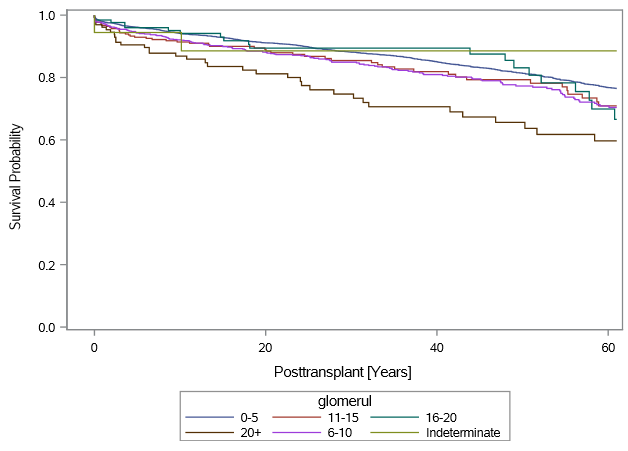Impact of Severity of Glomerulosclerosis on Long-Term Outcomes in Deceased Donor Renal Transplant Recipients with Donor Acute Kidney Injury
1University of California, San Francisco, San Francisco, CA, 2SUNY Downstate Medical Center, Brooklyn, NY
Meeting: 2020 American Transplant Congress
Abstract number: B-042
Keywords: Biopsy, Donors, marginal, Graft survival, Kidney transplantation
Session Information
Session Name: Poster Session B: Kidney Deceased Donor Selection
Session Type: Poster Session
Date: Saturday, May 30, 2020
Session Time: 3:15pm-4:00pm
 Presentation Time: 3:30pm-4:00pm
Presentation Time: 3:30pm-4:00pm
Location: Virtual
*Purpose: With long waitlist times for renal transplantation,there is a need to reduce discard rates of donor kidneys.The purpose of this study is to assess long term renal allograft outcomes in deceased donor renal transplants with donor acute kidney injury (AKI) based on degree of glomerulosclerosis seen on donor kidney biopsy at the time of transplantation.
*Methods: All adult primary solitary kidney deceased donor transplants (DDRT) performed between 2008 and 2018 reported to the UNOS/OPTN database in which donor kidney biopsy was available were analyzed. Based on terminal donor serum creatinine, the cohort was divided into 2 groups,serum creatinine <2mg/dl and >=2 mg dl. Renal allograft survival rates were computed according to Kaplan-Meier and Cox proportional hazards were used to estimate the impact of potential influential variables.
*Results: In this cohort,the number of kidneys with available donor kidney biopsy were 38,023 for donor serum creatinine< 2mg/dl (group1) and 7577 for serum creatinine >=2 mg/dl (group2). Of all DDRT during this time period, kidney pathology was available for 50% of those with donor creatinine < 2 mg /dl and 85.8% of those with donor creatinine 2 or greater. For group 1, donor serum creatinine <2 mg/dl,one and five-year renal allograft survival were (92.4%, 72.6%) for 0-5% glomerulosclerosis (90.9%,67.9%) for 6-10% glomerulosclerosis,(88.8%, 66%) for 11-15% glomerulosclerosis,(88.7%,66.9%) for 16-20% glomerulosclerosis and (88.1% ,66.1%) for >20% glomerulosclerosis seen on donor kidney. For group 2, donor serum creatinine >=2 mg./dl, one and five-year renal allograft survival were (93.6%,76.7%) for 0-5% glomerulosclerosis,(90.9%,67.9%) for 6-10% glomerulosclerosis,(90.9%,70.9%) for 11-15% glomerulosclerosis,(94%,69.9%) for 16-20% glomerulosclerosis and (85.9%, 59.7%) for >20% glomerulosclerosis respectively.Figure1 shows renal allograft survival in deceased donor renal transplant recipients with donor serum creatinine >=2mg/dl stratified by degree of glomerulosclerosis.
*Conclusions: Use of carefully selected kidneys with donor AKI have comparable outcomes to those with lower donor serum creatinine at the time of transplantation. Degree of glomerulosclerosis on histopathology in donor kidney may guide in this process.
To cite this abstract in AMA style:
Brar A, Gruessner A, Adey D, Salifu M. Impact of Severity of Glomerulosclerosis on Long-Term Outcomes in Deceased Donor Renal Transplant Recipients with Donor Acute Kidney Injury [abstract]. Am J Transplant. 2020; 20 (suppl 3). https://atcmeetingabstracts.com/abstract/impact-of-severity-of-glomerulosclerosis-on-long-term-outcomes-in-deceased-donor-renal-transplant-recipients-with-donor-acute-kidney-injury/. Accessed December 17, 2025.« Back to 2020 American Transplant Congress

